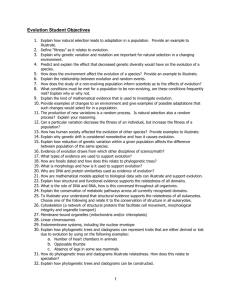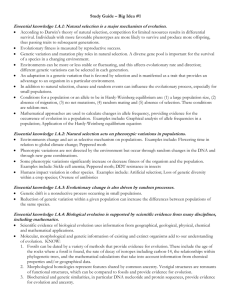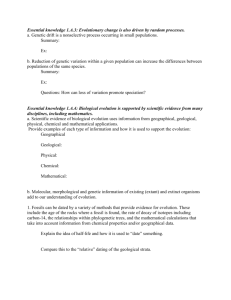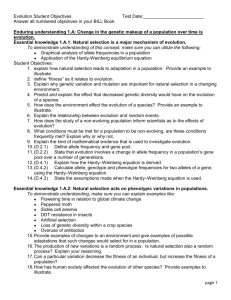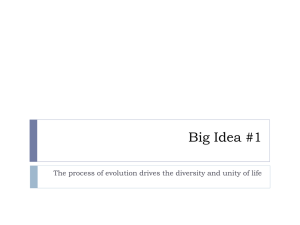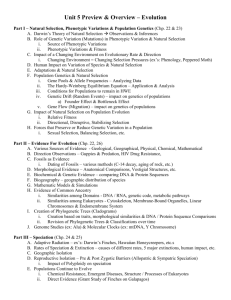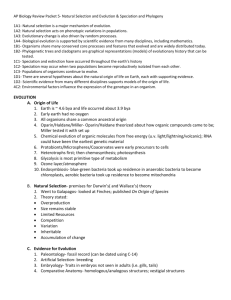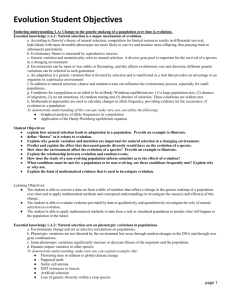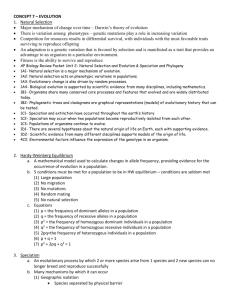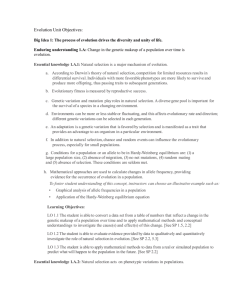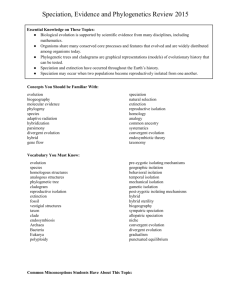Evolution Unit
advertisement
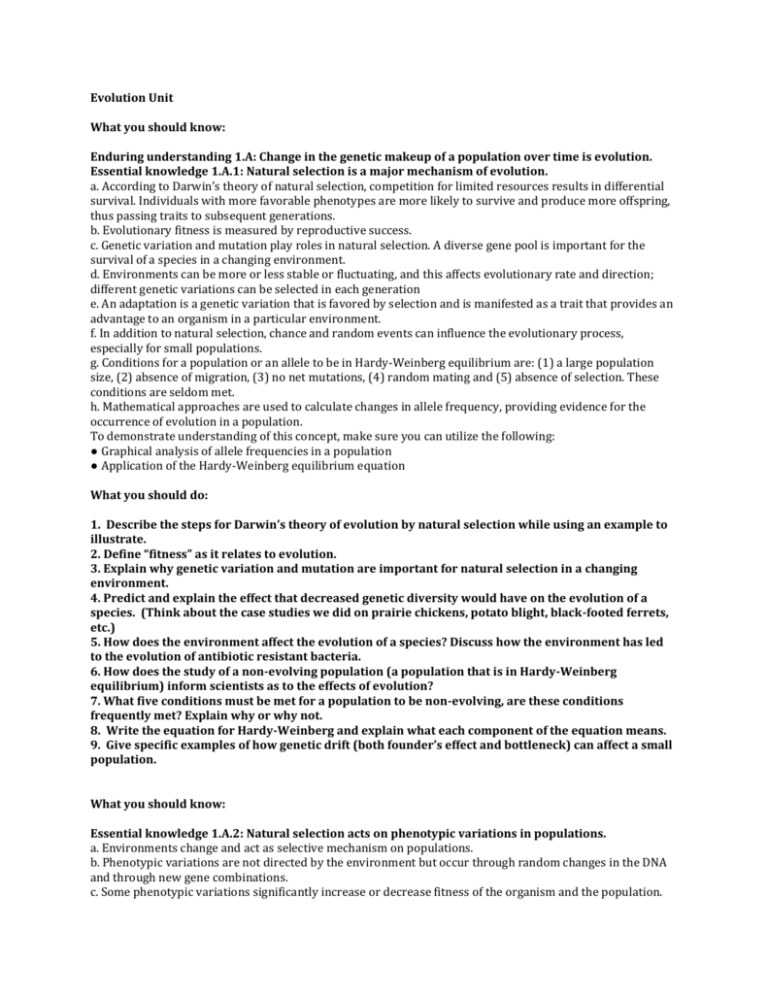
Evolution Unit What you should know: Enduring understanding 1.A: Change in the genetic makeup of a population over time is evolution. Essential knowledge 1.A.1: Natural selection is a major mechanism of evolution. a. According to Darwin’s theory of natural selection, competition for limited resources results in differential survival. Individuals with more favorable phenotypes are more likely to survive and produce more offspring, thus passing traits to subsequent generations. b. Evolutionary fitness is measured by reproductive success. c. Genetic variation and mutation play roles in natural selection. A diverse gene pool is important for the survival of a species in a changing environment. d. Environments can be more or less stable or fluctuating, and this affects evolutionary rate and direction; different genetic variations can be selected in each generation e. An adaptation is a genetic variation that is favored by selection and is manifested as a trait that provides an advantage to an organism in a particular environment. f. In addition to natural selection, chance and random events can influence the evolutionary process, especially for small populations. g. Conditions for a population or an allele to be in Hardy-Weinberg equilibrium are: (1) a large population size, (2) absence of migration, (3) no net mutations, (4) random mating and (5) absence of selection. These conditions are seldom met. h. Mathematical approaches are used to calculate changes in allele frequency, providing evidence for the occurrence of evolution in a population. To demonstrate understanding of this concept, make sure you can utilize the following: ● Graphical analysis of allele frequencies in a population ● Application of the Hardy-Weinberg equilibrium equation What you should do: 1. Describe the steps for Darwin’s theory of evolution by natural selection while using an example to illustrate. 2. Define “fitness” as it relates to evolution. 3. Explain why genetic variation and mutation are important for natural selection in a changing environment. 4. Predict and explain the effect that decreased genetic diversity would have on the evolution of a species. (Think about the case studies we did on prairie chickens, potato blight, black-footed ferrets, etc.) 5. How does the environment affect the evolution of a species? Discuss how the environment has led to the evolution of antibiotic resistant bacteria. 6. How does the study of a non-evolving population (a population that is in Hardy-Weinberg equilibrium) inform scientists as to the effects of evolution? 7. What five conditions must be met for a population to be non-evolving, are these conditions frequently met? Explain why or why not. 8. Write the equation for Hardy-Weinberg and explain what each component of the equation means. 9. Give specific examples of how genetic drift (both founder’s effect and bottleneck) can affect a small population. What you should know: Essential knowledge 1.A.2: Natural selection acts on phenotypic variations in populations. a. Environments change and act as selective mechanism on populations. b. Phenotypic variations are not directed by the environment but occur through random changes in the DNA and through new gene combinations. c. Some phenotypic variations significantly increase or decrease fitness of the organism and the population. d. Humans impact variation in other species. To demonstrate understanding, make sure you can explain examples like: Sickle cell anemia DDT resistance in insects Artificial selection Loss of genetic diversity within a crop species Overuse of antibiotics What you should do: Student Objectives: 1. Provide examples of changes to an environment and give examples of possible adaptations that such changes would select for in a population. 2. The production of new variations (mutations) is a random process. Is natural selection also a random process? Explain your reasoning. 3. Give an example of a mutation/variation that could decrease the fitness of an individual and a population. Give an example of a mutation/variation that could increase the fitness of an individual and subsequently a population. 4. How has human society affected the evolution of other species? Provide examples to illustrate. (Use the list above.) What you should know: Essential knowledge 1.A.4: Biological evolution is supported by scientific evidence from many disciplines, including mathematics. a. Scientific evidence of biological evolution uses information from geographical, geological, physical, chemical and mathematical applications. b. Molecular, morphological and genetic information of existing and extinct organisms add to our understanding of evolution. Evidence of student learning is a demonstrated understanding of each of the following: 1. Fossils can be dated by a variety of methods that provide evidence for evolution. These include the age of the rocks where a fossil is found, the rate of decay of isotopes including carbon-14, the relationships within phylogenetic trees, and the mathematical calculations that take into account information from chemical properties and/or geographical data. 2. Morphological homologies represent features shared by common ancestry. Vestigial structures are remnants of functional structures, which can be compared to fossils and provide evidence for evolution. 3. Biochemical and genetic similarities, in particular DNA nucleotide and protein sequences, provide evidence for evolution and ancestry. 4. Mathematical models and simulations can be used to illustrate and support evolutionary concepts. To demonstrate understanding, make sure you can do the following: Graphical analyses of allele frequencies in a population Analysis of sequence data sets Analysis of phylogenetic trees Construction of phylogenetic trees based on sequence data What you should do: 1. Describe two ways fossils are dated and how does this relate to phylogenetic trees? 2. What is morphology and how is it used to support evolution? (Use homologous and analogous structures here while using the words divergent and convergent evolution.) 3. How are DNA and protein similarities (Biochemical) used as evidence of evolution? (Use the information gleaned from the BLAST lab.) What you should know: Enduring understanding 1.B: Organisms are linked by lines of descent from common ancestry. Essential knowledge 1.B.1: Organisms share many conserved core processes and features that evolved and are widely distributed among organisms today. a. Structural and functional evidence supports the relatedness of all domains. Evidence of student learning is a demonstrated understanding of each of the following: 1. DNA and RNA are carriers of genetic information through transcription, translation and replication. 2. Major features of the genetic code are shared by all modern living systems. 3. Metabolic pathways are conserved across all currently recognized domains. b. Structural evidence supports the relatedness of all eukaryotes. To foster student understanding of this concept, instructors can choose an illustrative example such as: Cytoskeleton (a network of structural proteins that facilitate cell movement, morphological integrity and organelle transport) Membrane-bound organelles (mitochondria and/or chloroplasts) Linear chromosomes Endomembrane systems, including the nuclear envelope Student Objectives: 1. Which cellular process breaks down glucose for energy and occurs across all domains of organisms? (Archaea, Eubacteria, Eukaryotes) 2. What is the role of DNA and RNA, and how are these functions conserved throughout all organisms? 3. To illustrate your understand that structural evidence supports the relatedness of all eukaryotes, choose one of the following and relate it to the conservation of structure in all eukaryotes. Membrane-bound organelles (mitochondria and/or chloroplasts)***I would pick this one and talk about endosymbiont theory. Linear chromosomes Endomembrane systems, including the nuclear envelope What you should know: Essential knowledge 1.B.2: Phylogenetic trees and cladograms are graphical representations (models) of evolutionary history that can be tested. a. Phylogenetic trees and cladograms can represent traits that are either derived or lost due to evolution. To demonstrate understanding, make sure you can explain the following: Number of heart chambers in animals Opposable thumbs Absence of legs in some sea mammals b. Phylogenetic trees and cladograms illustrate speciation that has occurred, in that relatedness of any two groups on the tree is shown by how recently two groups had a common ancestor. c. Phylogenetic trees and cladograms can be constructed from morphological similarities of living or fossil species, and from DNA and protein sequence similarities, by employing computer programs that have sophisticated ways of measuring and representing relatedness among organisms. d. Phylogenetic trees and cladograms are dynamic (i.e., phylogenetic trees and cladograms are constantly being revised), based on the biological data used, new mathematical and computational ideas, and current and emerging knowledge. What you should do: Student Objectives: 1. Diagram how phylogenetic trees and cladograms can represent traits that are either derived or lost due to evolution by using one the following examples: (So you should draw a cladogram here and identify the point of the common ancestor.) Number of heart chambers in animals (I would use this one and think about your play-doh models) Opposable thumbs Absence of legs in some sea mammals 2. How do phylogenetic trees and cladograms illustrate relatedness. How does this relate to speciation? 3. Explain how phylogenetic trees and cladograms can be constructed. (You should use your cytochrome C paper lab here or the BLAST computer lab example.) 4. How does the biological data used, new mathematical and computational ideas, and current and emerging knowledge affect phylogenic tree and cladogram construction? What you should know: Enduring understanding 1.C: Life continues to evolve within a changing environment. Essential knowledge 1.C.1: Speciation and extinction have occurred throughout the Earth’s history. a. Speciation rates can vary, especially when adaptive radiation occurs when new habitats become available. b. Species extinction rates are rapid at times of ecological stress. [See also 4.C.3] To demonstrate understanding, make sure you can explain the following: Five major extinctions Human impact on ecosystems and species extinction rates What you should do: 1. Explain how adaptive radiation and new habitats becoming available affect the speciation rate. 2. Explain how species extinction rates are rapid at times of ecological stress by applying the concept to one of the following examples. (Use your “Human Driven Doomsday” article here.) Five major extinctions Human impact on ecosystems and species extinction rates What you should know: Essential knowledge 1.C.2: Speciation may occur when two populations become reproductively isolated from each other. a. Speciation results in diversity of life forms. Species can be physically separated by a geographic barrier such as an ocean or a mountain range, or various pre-and post-zygotic mechanisms can maintain reproductive isolation and prevent gene flow. b. New species arise from reproductive isolation over time, which can involve scales of hundreds of thousands or even millions of years, or speciation can occur rapidly through mechanisms such as polyploidy in plants. What you should do: 1. Explain how speciation occurs, including allopatric, sympatric, and parapatric speciation. 2. Discuss pre-and post-zygotic mechanisms that can maintain reproductive isolation and prevent gene flow. 3. What is the rate of most speciation, and how does polyploidy change the rate of speciation. What you should know: Essential knowledge 1.C.3: Populations of organisms continue to evolve. a. Scientific evidence supports the idea that evolution has occurred in all species. b. Scientific evidence supports the idea that evolution continues to occur. To foster student understanding of this concept, make sure you can explain the following: ● Chemical resistance (mutations for resistance to antibiotics, pesticides, herbicides or chemotherapy drugs occur in the absence of the chemical) ● Emergent diseases ● Observed directional phenotypic change in a population (Grants’ observations of Darwin’s finches in the Galapagos) ● A eukaryotic example that describes evolution of a structure or process such as heart chambers, limbs, the brain and the immune system What you should do: 1. Describe the types of scientific evidence that supports the idea that evolution has occurred in all species. 2. Using an example below, describe the scientific evidence that supports the idea that evolution continues to occur. ○ Chemical resistance (mutations for resistance to antibiotics, pesticides, herbicides or chemotherapy drugs occur in the absence of the chemical) ○ Emergent diseases ○ Observed directional phenotypic change in a population (Grants’ observations of Darwin’s finches in the Galapagos) ○ A eukaryotic example that describes evolution of a structure or process such as heart chambers, limbs, the brain and the immune system What you should know: Enduring understanding 1.D: The origin of living systems is explained by natural processes. Essential knowledge 1.D.1: There are several hypotheses about the natural origin of life on Earth, each with supporting scientific evidence. a. Scientific evidence supports the various models. Evidence of student learning is a demonstrated understanding of each of the following: 1. Primitive Earth provided inorganic precursors from which organic molecules could have been synthesized due to the presence of available free energy and the absence of a significant quantity of oxygen. 2. In turn, these molecules served as monomers or building blocks for the formation of more complex molecules, including amino acids and nucleotides. 3. The joining of these monomers produced polymers with the ability to replicate, store and transfer information. 4. These complex reaction sets could have occurred in solution (organic soup model) or as reactions on solid reactive surfaces. 5. The RNA World hypothesis proposes that RNA could have been the earliest genetic material. What you should do: (Use your origin of life drawings here.) 1. Describe one hypothesis about the natural origin of life on earth with the scientific evidence that supports the model. *May want to do bubble hypothesis since you drew it. 2. Discuss what was required of Primitive Earth for the synthesis of organic molecules 3. Identity what could have occurred to these newly synthesized organic molecules to further the development of life on Earth. 4. Why are polymers with the ability to replicate, store and transfer information important to the origin of life? 5. Describe the primordial soup model. 6. Explain the RNA World hypothesis. What you should know: Essential knowledge 1.D.2: Scientific evidence from many different disciplines supports models of the origin of life. a. Geological evidence provides support for models of the origin of life on Earth. Evidence of student learning is a demonstrated understanding of each of the following: 1. The Earth formed approximately 4.6 billion years ago (bya), and the environment was too hostile for life until 3.9 bya, while the earliest fossil evidence for life dates to 3.5 bya. Taken together, this evidence provides a plausible range of dates when the origin of life could have occurred. 2. Chemical experiments have shown that it is possible to form complex organic molecules from inorganic molecules in the absence of life. b. Molecular and genetic evidence from extant and extinct organisms indicates that all organisms on Earth share a common ancestral origin of life. Evidence of student learning is a demonstrated understanding of each of the following: ● Scientific evidence includes molecular building blocks that are common to all life forms. ● Scientific evidence includes a common genetic code. What you should do: 1. Describe the timeline of the formation of the Earth, the formation of life, and the formation of eukaryotic cells. Describe the evidence used to support this timeline. 2. Describe the chemical experiments that show that it is possible to form complex organic molecules from inorganic molecules while simulating conditions on early Earth. 3.Discuss the molecular and genetic evidence from extant and extinct organisms which indicates that all organisms on Earth share a common ancestral origin of life. (Use information from your BLAST lab as well as the Founder Mutation Article) 4. What are some methods we’ve used to show that molecular building blocks ( amino acid sequences) and DNA evidence (common genetic code) are common to all life forms?
